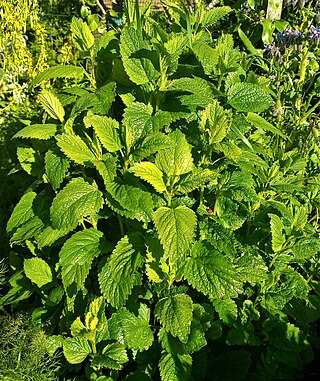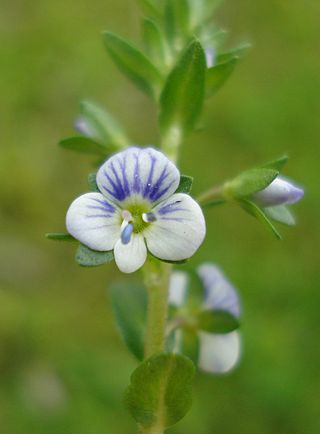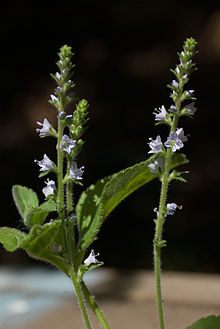
Lemon balm is a perennial herbaceous plant in the mint family and native to south-central Europe, the Mediterranean Basin, Iran, and Central Asia, but now naturalised elsewhere.

Althaea officinalis, the marsh mallow or marshmallow, is a species of flowering plant indigenous to Europe, Western Asia and North Africa, which is used in herbalism and as an ornamental plant. A confection made from the root since ancient Egyptian times evolved into today's marshmallow treat, but most modern marshmallow treats no longer contain any marsh-mallow root.

Veronica chamaedrys, the germander speedwell, bird's-eye speedwell, or cat's eyes, is a herbaceous perennial species of flowering plant in the plantain family Plantaginaceae.

Silene dioica, known as red campion and red catchfly, is a herbaceous flowering plant in the family Caryophyllaceae, native to Europe and introduced to the Americas.

Lavandula angustifolia, formerly L. officinalis, is a flowering plant in the family Lamiaceae, native to the Mediterranean. Its common names include lavender, true lavender and English lavender ; also garden lavender, common lavender and narrow-leaved lavender.

Lamium amplexicaule, commonly known as common henbit, or greater henbit, is a species of Lamium native to Europe, Asia and northern Africa.

Veronica persica is a flowering plant in the family Plantaginaceae. Common names include birdeye speedwell, common field-speedwell, Persian speedwell, large field speedwell, bird's-eye, or winter speedwell. It is native to Eurasia and is widespread as an introduced species in the British Isles, North America, eastern Asia, including Japan and China, and Australia and New Zealand.

Pentaglottis is a monotypic genus of flowering plants in the family Boraginaceae. It is represented by a single species, Pentaglottis sempervirens, commonly known as green alkanet or evergreen bugloss, and it is one of several related plants known as alkanet. It is a bristly, perennial plant native to southwestern Europe, in northwest Iberia and France.

Calendula officinalis, the pot marigold, common marigold, ruddles, Mary's gold or Scotch marigold, is a flowering plant in the daisy family Asteraceae. It is probably native to southern Europe, though its long history of cultivation makes its precise origin unknown, and it may possibly be of garden origin. It is also widely naturalised farther north in Europe and elsewhere in warm temperate regions of the world.

Veronica arvensis, common names: wall speedwell, corn speedwell, common speedwell, rock speedwell, field speedwell, is an annual flowering plant in the plantain family Plantaginaceae. The species is native to Europe and a common weed in gardens, pastures, waste places, and cultivated land.

Veronica hederifolia, the ivy-leaved speedwell, is a flowering plant belonging to the family Plantaginaceae. It is native to Europe, western Asia and north Africa and it is present in other places as an introduced species and a common weed. Solitary blue flowers occur in leaf axils, each with a corolla up to one centimetre (0.4 in) wide. The fruit is a dehiscent capsule.

Echinops sphaerocephalus, known by the common names glandular globe-thistle, great globe-thistle or pale globe-thistle, is a Eurasian species of globe-thistle belonging to the tribe Cardueae within the family Asteraceae.

Veronica longifolia, known as garden speedwell or longleaf speedwell, is a flowering plant in the family Plantaginaceae.

Veronica serpyllifolia, the thyme-leaved speedwell or thymeleaf speedwell, is a perennial flowering plant in the plantain family. It is native to Europe, but can be found elsewhere on most continents as an introduced species.

Paeonia officinalis, the common peony, or garden peony, is a species of flowering plant in the family Paeoniaceae, native to mainly mountainous areas of Southern Europe and introduced in Central and Western Europe and North America.

Veronica anagallis-aquatica is a species of flowering plant in the family Plantaginaceae known by the common names water speedwell, blue water-speedwell,brook pimpernel.

Veronica filiformis is a species of flowering plant in the family Plantaginaceae. It is known by many common names, including slender speedwell, creeping speedwell, threadstalk speedwell and Whetzel weed. It is native to eastern Europe and western Asia, and it is known in many other regions as an introduced species.

Veronica scutellata is a species of flowering plant in the plantain family known by the common names marsh speedwell, skullcap speedwell, and grassleaf speedwell. It is native to temperate Asia, Europe, northern Africa, and northern North America, including most of Canada and the northern half of the United States. It occurs in moist and wet habitats, such as ponds, marshes and other wetlands. It is a rhizomatous herbaceous perennial producing a decumbent or upright stem 40–60 cm (16–24 in) in maximum height. It is mostly hairless in texture. The purple-green or reddish leaves are oppositely arranged in pairs about the stem, the blades lance-shaped and smooth-edged. The inflorescence is an open array of several flowers on thin, straight pedicels. The flower is up to 1 cm (0.39 in) wide with four lobes, the upper lobe being largest. It is white, blue, or purplish with purple veining. It yields a flat, notched capsule a few millimeters wide.

Veronica austriaca, the broadleaf speedwell, large speedwell, Austrian speedwell, or saw-leaved speedwell, is a species of flowering plant in the plantain family Plantaginaceae, native to northern temperate Europe. Growing to 90 cm (35 in) tall by 60 cm (24 in) broad, it is a mound-forming herbaceous perennial, with deeply toothed leaves and erect spikes of bright blue flowers throughout summer.

Clinopodium menthifolium, commonly known as the wood calamint or woodland calamint, is a species of flowering plant in the mint family, Lamiaceae. It is found throughout southern and central Europe from the United Kingdom and east as far as temperate parts of Asia, and as south as North Africa. It grows up to 1,700 m (5,600 ft) in elevation.






















